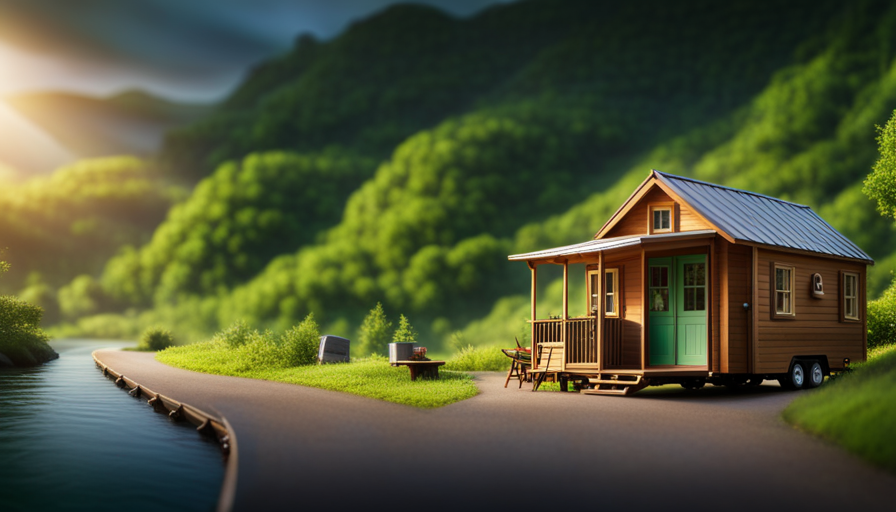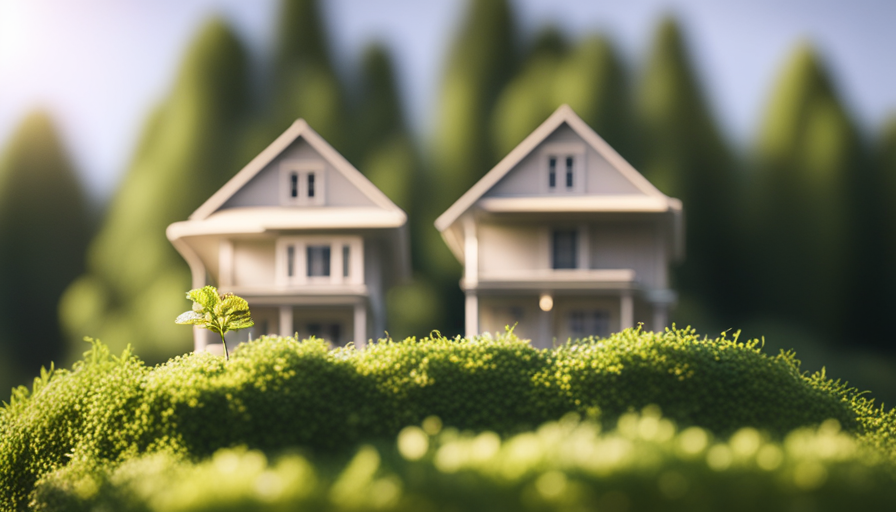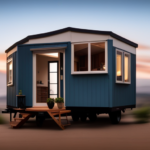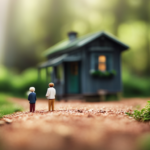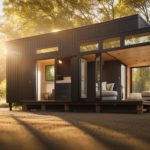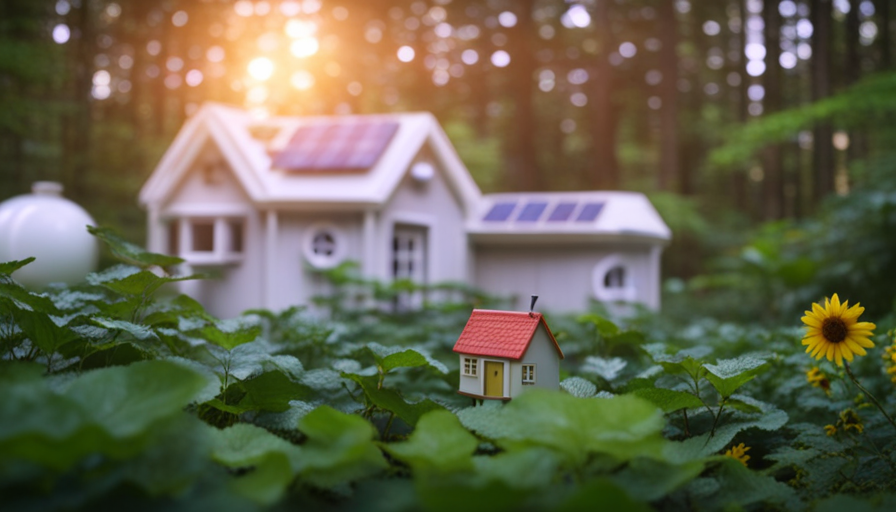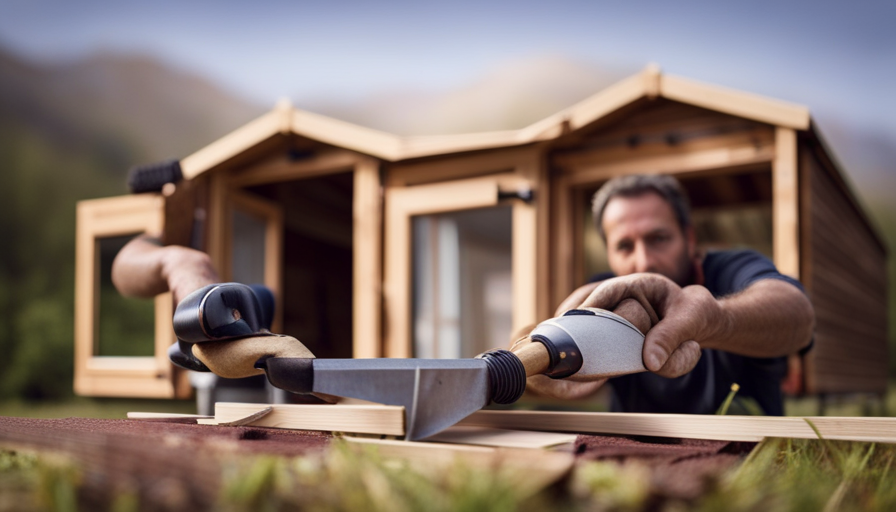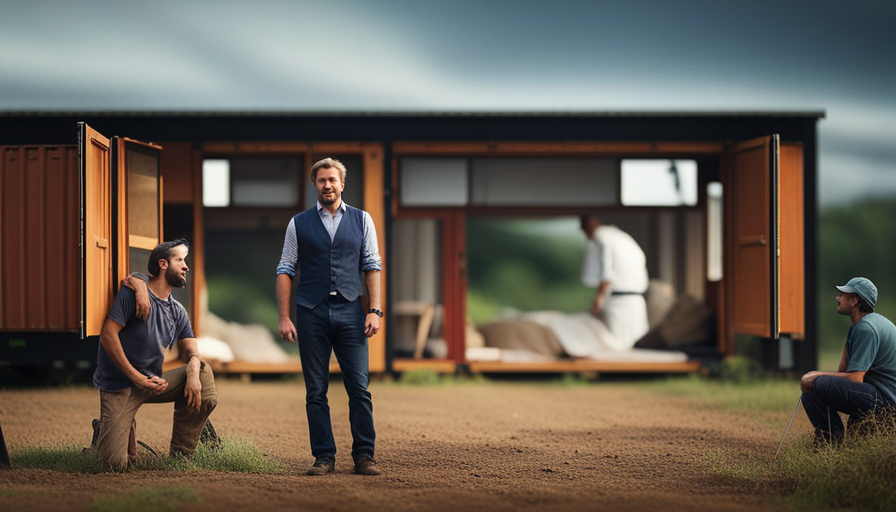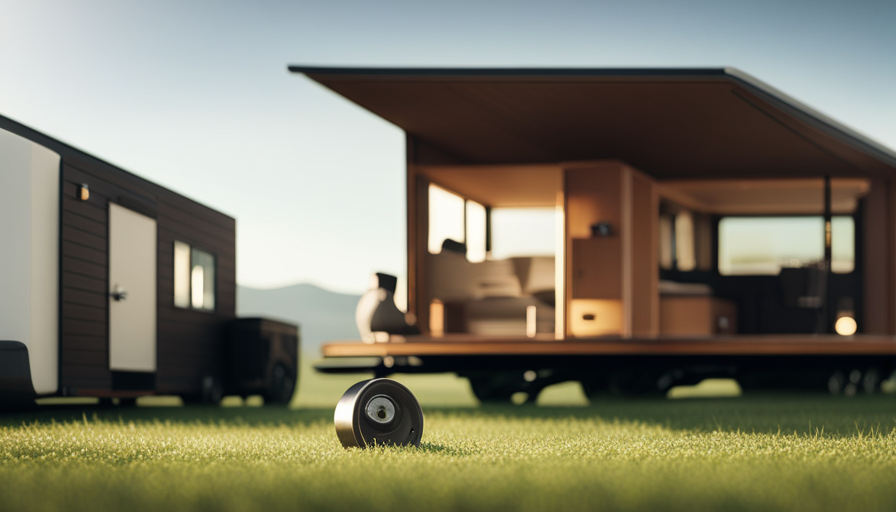Picture this: a cozy, charming home that lets you follow your dreams wherever they may take you. A tiny house on wheels offers just that – the freedom to roam, while also offering a comfortable and affordable place to call home.
But how much does it really cost to own one of these mobile dwellings? In this article, I’ll break down the various factors that influence the price of a tiny house on wheels, as well as the monetary and non-monetary expenses associated with tiny house living.
From exploring budget-friendly options to financing your dream home, I’ll provide you with all the information you need to make an informed decision. So, if you’ve ever wondered how much a tiny house on wheels costs and if it’s the right choice for you, keep reading to find out.
Key Takeaways
- Factors influencing the cost of a tiny house on wheels include size, materials, customization, and location.
- Building a tiny house yourself saves money on labor costs but requires time, skill, and resources.
- Hiring a professional builder is more expensive upfront but ensures quality workmanship and saves time.
- Larger tiny houses cost more due to increased materials and labor.
Understanding the Basics of Tiny House Living
Tiny house living entails comprehending the fundamentals and intricacies of residing in a diminutive dwelling on wheels. It’s not just about downsizing your space, but also about embracing a simpler and more sustainable lifestyle.
One of the first things to consider when it comes to tiny house living is the cost of maintenance. While the initial cost of a tiny house may be lower than that of a traditional home, it’s important to factor in ongoing expenses such as utilities, insurance, and repairs.
Additionally, legal considerations are crucial when living in a tiny house on wheels. Zoning laws and building codes vary from place to place, and it’s essential to ensure that your tiny house complies with all regulations to avoid any legal issues.
Understanding the basics of tiny house living can help you make an informed decision about whether it’s the right lifestyle choice for you.
Transitioning into the subsequent section about factors that influence the price of a tiny house on wheels, it’s important to note that the cost of a tiny house can vary greatly depending on a variety of factors.
Factors That Influence the Price of a Tiny House on Wheels
When considering purchasing a mobile dwelling, there are several factors that will impact the overall cost. Factors influencing the price of a tiny house on wheels include size, materials used, customization, and location.
One of the biggest decisions to make is whether to build the tiny house yourself or hire a professional builder. DIY projects can save money on labor costs, but it requires a significant amount of time, skill, and resources. Hiring a professional builder may be more expensive upfront, but it ensures quality workmanship and can save time and stress.
The size of the tiny house is another key factor. Larger tiny houses will naturally cost more due to the increased materials and labor required. Additionally, the choice of materials can greatly affect the price. High-quality, sustainable materials will be more expensive but can provide long-term cost savings through energy efficiency and durability. Customization options, such as unique designs or high-end finishes, will also increase the price.
Location plays a role as well. Different areas have different costs of living, which can impact the price of materials and the availability of skilled labor. It’s important to consider these factors when budgeting for a tiny house on wheels.
The factors influencing the price of a tiny house on wheels include DIY vs professional builders, size, materials used, customization, and location. Evaluating these factors will help determine the monetary costs of tiny house living.
Evaluating the Monetary Costs of Tiny House Living
To evaluate the monetary costs of living in a tiny house on wheels, you may be surprised by the financial benefits that come with downsizing and embracing a minimalist lifestyle. Here are four key aspects to consider when evaluating the long-term financial viability of tiny house living:
-
Building vs. Buying: One of the first decisions you’ll need to make is whether to build your own tiny house or purchase a pre-built one. Building a tiny house can be a cost-effective option if you have the necessary skills and resources. Alternatively, buying a ready-made tiny house may save you time and effort.
-
Initial Investment: The cost of a tiny house on wheels can vary greatly depending on factors such as size, materials used, and level of customization. While there is an upfront investment, it’s often significantly lower than that of a traditional home.
-
Reduced Monthly Expenses: Living in a tiny house typically means reduced utility bills, lower property taxes, and minimal maintenance costs. With fewer square feet to heat, cool, and maintain, you can save a substantial amount of money each month.
-
Potential for Income Generation: Some tiny house owners choose to rent out their tiny homes when they’re not in use, providing an additional source of income.
By evaluating the long-term financial viability of tiny house living and comparing the costs of building vs. buying, you can make an informed decision about whether this lifestyle is right for you.
When considering the non-monetary expenses of tiny house living, there are other important factors to take into account.
Considering the Non-Monetary Expenses of Tiny House Living
Living in a compact and mobile dwelling like a tiny house allows me to focus on experiences, connections, and personal growth rather than being tied down by the burdens of a traditional home. While the monetary benefits of tiny house living are evident, it’s also important to consider the non-monetary benefits and social aspects of this lifestyle.
One of the most significant non-monetary benefits of living in a tiny house on wheels is the opportunity to foster stronger connections with loved ones and the community. With limited space, it encourages intentional and meaningful interactions with family and friends. Whether it’s sharing a meal, engaging in a conversation, or simply spending quality time together, living in a tiny house promotes a sense of closeness and togetherness.
Additionally, tiny house living offers a chance to be more environmentally conscious and reduce one’s carbon footprint. With smaller living spaces, it becomes easier to adopt sustainable practices such as using renewable energy sources, minimizing waste, and conserving resources. This not only benefits the environment but also contributes to a healthier and more sustainable lifestyle.
The non-monetary benefits of tiny house living are numerous, ranging from stronger social connections to a more sustainable way of life. By embracing this lifestyle, I’m not only freeing myself from the financial burdens of a traditional home but also creating a space that prioritizes experiences, relationships, and personal growth.
Transitioning into the subsequent section about exploring budget-friendly tiny house options, it’s crucial to consider both the monetary and non-monetary aspects when making this decision.
Exploring Budget-Friendly Tiny House Options
One of the best parts about going for a budget-friendly option for your tiny home is that you can get creative and find unique ways to make the most of your space.
When it comes to cost-effective design, there are plenty of alternative housing options to consider. For example, you could explore repurposing shipping containers or converting old buses into tiny homes. These options not only provide an affordable way to live in a tiny house, but they also offer a unique and stylish living space.
Another budget-friendly option is to build your tiny house yourself. DIY tiny houses can be a great way to save money, as you can do much of the work on your own and use reclaimed materials. However, it’s important to note that building a tiny house requires a certain level of skill and knowledge. If you’re not confident in your abilities, it may be worth considering hiring a professional builder. While this may be a more expensive option upfront, it can save you time and ensure that your tiny home is built to code.
When deciding between DIY and professional builders, it’s important to weigh the pros and cons of each option.
DIY vs. Professional Builders: Pros and Cons
Opting for a DIY build can ignite your creativity and provide a sense of pride in crafting your own unique living space. When it comes to choosing between a DIY build and hiring professional builders for your tiny house on wheels, there are several factors to consider. Let’s take a look at the cost comparison, pros, and cons of each option.
DIY vs. Professional Builders: Pros and Cons
-
Cost Comparison:
-
DIY: Building your own tiny house on wheels can be more cost-effective as you have control over every aspect, from materials to labor.
-
Professional Builders: Hiring professionals may result in higher upfront costs, but they can save you time and ensure high-quality workmanship.
-
Pros and Cons:
-
DIY: By building your own tiny house, you have the freedom to customize every detail according to your preferences. However, it requires significant time, effort, and knowledge of construction.
-
Professional Builders: Hiring professionals can provide you with expertise and experience, ensuring a well-built and structurally sound tiny house. On the downside, you may have limited control over the design and may need to compromise on certain aspects.
Transitioning into the next section, it’s essential to consider financing options for your tiny house on wheels.
Financing Your Tiny House on Wheels
When it comes to financing a tiny house on wheels, there are several key points to consider.
First, saving and budgeting is crucial in order to have enough funds to build or purchase your tiny house.
Second, loans and financing programs can provide assistance for those who need additional financial support.
Lastly, crowdfunding and grants are alternative options that may be available for individuals seeking funding for their tiny house project.
Saving and Budgeting
While it may be challenging, it’s worth considering the potential savings and budgeting benefits of owning a tiny house on wheels. Here are some saving strategies and cost-effective materials to consider when building or buying a tiny house:
-
Energy efficiency: By using insulation and energy-saving appliances, you can significantly reduce your monthly utility bills.
-
Minimalist lifestyle: Downsizing and embracing a minimalist lifestyle can save you money by reducing the need for unnecessary purchases.
-
DIY projects: Taking on do-it-yourself projects can save you money on labor costs and allow you to personalize your tiny house.
-
Sustainable materials: Using reclaimed or recycled materials for construction can be both environmentally friendly and cost-effective.
By implementing these saving strategies and opting for cost-effective materials, you can create a tiny house on wheels that fits your budget.
Transitioning into the subsequent section about loans and financing programs, it’s important to explore these options to make your dream of owning a tiny house a reality.
Loans and Financing Programs
To make your dream of owning a tiny house on wheels a reality, you may be interested to know that there are various loans and financing programs available to assist you in securing the necessary funds.
When it comes to financing options for a tiny house on wheels, there are a few avenues you can explore. One option is to apply for a personal loan from a bank or credit union. These loans typically have higher interest rates and shorter repayment terms, but they can provide you with the funds you need upfront.
Another option is to look into specialized financing programs that are specifically designed for tiny houses on wheels. These programs may offer more flexible terms and lower interest rates.
Transitioning into the subsequent section about crowdfunding and grants, it’s important to explore all your options to find the best solution for financing your tiny house on wheels.
Crowdfunding and Grants
Consider exploring crowdfunding and grants as potential sources of funding to help you turn your dream of owning a mobile home into a reality. Crowdfunding opportunities provide a platform for individuals to raise money from a large number of people who believe in their project. Websites like Kickstarter and GoFundMe have helped many individuals secure funds for their tiny house on wheels.
Additionally, grants can be a great option for funding. Many organizations offer grants specifically for housing projects, including those focused on sustainable and affordable living. These grants typically require an application process, where you’ll need to demonstrate the feasibility and impact of your tiny house project.
By utilizing crowdfunding and grants, you can secure the financial support needed to start building your own tiny house on wheels.
Now, let’s move on to some tips for finding the right tiny house on wheels.
Tips for Finding the Right Tiny House on Wheels
When searching for the perfect tiny house on wheels, imagine yourself exploring a cozy space that fits your unique lifestyle. Finding the right tiny house on wheels can be an exciting and fulfilling process.
One important factor to consider is the location where you plan to park your tiny house. Whether it’s a backyard, an RV park, or a piece of land, finding the perfect spot is essential. Research local zoning laws and regulations to ensure that you can legally park your tiny house in your desired location.
Another key aspect to consider is maximizing space in your tiny house. Since these homes are small, every inch counts. Look for clever storage solutions, such as built-in cabinets, hidden compartments, and multi-functional furniture. Consider the layout of the house and how it will suit your lifestyle. Think about your daily routines and activities to determine if the layout is functional and efficient.
Finding the right tiny house on wheels involves considering the location where you plan to park it and maximizing the space within the house. By researching local zoning laws and regulations and thinking about your lifestyle and daily routines, you can find a tiny house that perfectly suits your needs.
However, there are also hidden costs to consider before purchasing a tiny house on wheels, which we will explore in the next section.
Hidden Costs to Consider Before Purchasing a Tiny House on Wheels
Before you make the decision to buy a tiny house on wheels, be aware of the potential hidden expenses that may arise along the way. While the initial cost of a tiny house on wheels may seem affordable, there are additional hidden costs that you need to consider.
One of these hidden costs is maintenance expenses. Just like any other home, a tiny house on wheels requires regular maintenance to keep it in good condition. This includes regular cleaning, repairs, and replacements of parts that may wear out over time.
Additionally, you need to factor in the costs of insurance and permits. Depending on your location, you may be required to obtain permits for parking and living in a tiny house on wheels. These permits can come with a price tag. Insurance is also important to protect your investment. Although insurance for tiny houses on wheels can be more affordable than traditional home insurance, it is still an additional expense that needs to be considered.
As you can see, there are hidden costs associated with owning a tiny house on wheels. It’s important to take these into account before making a decision.
Next, we will explore the factors you should consider when determining if a tiny house on wheels is right for you.
Making the Decision: Is a Tiny House on Wheels Right for You?
Deciding if a tiny house on wheels is the right fit for you involves carefully evaluating your lifestyle and priorities. Making the transition to tiny house living can be a significant adjustment, but it can also offer many benefits.
Here are a few things to consider when deciding if a tiny house on wheels is right for you:
-
Financial Freedom: One of the main advantages of living in a tiny house on wheels is the potential for financial freedom. With a smaller space and fewer expenses, you can save money and reduce your overall cost of living.
-
Minimalistic Lifestyle: Living in a tiny house on wheels requires downsizing and simplifying your belongings. It encourages a minimalistic lifestyle, which can lead to less clutter and a greater sense of freedom.
-
Finding Community: Connecting with other tiny house enthusiasts can be a rewarding experience. There are numerous online communities, workshops, and events where you can meet like-minded individuals and share your tiny house journey.
Making the decision to live in a tiny house on wheels is a personal choice that requires careful consideration. It’s essential to weigh the pros and cons and assess if the benefits align with your lifestyle and goals.
Adjusting to tiny house living may take time, but with the right mindset and support, it can be a fulfilling and transformative experience.
Frequently Asked Questions
Are tiny houses on wheels legal in all areas?
Tiny houses on wheels aren’t legal in all areas due to zoning regulations. For example, in some cities, they’re only allowed in designated areas or RV parks.
The advantages of tiny houses on wheels include mobility and affordability. They can be moved to different locations and are often cheaper than traditional homes.
However, disadvantages include limited space and potential parking restrictions. It’s important to research local regulations before considering a tiny house on wheels.
How much does it cost to insure a tiny house on wheels?
The cost to insure a tiny house on wheels can vary depending on several factors. These factors include the cost of materials used in construction, the construction time, and the value of the finished structure. Generally, insurance for a tiny house on wheels is similar to insuring a conventional home, but with some differences due to its mobility. It’s important to consult with insurance providers who specialize in tiny homes to ensure you have adequate coverage for your specific needs.
Can I park my tiny house on wheels on my own property?
Sure, you can park your tiny house on wheels on your own property, but it’s important to consider parking regulations and zoning laws in your area.
These regulations vary by location and may restrict the size, placement, and duration of parking. Before parking your tiny house, it’s wise to research and comply with these regulations to avoid any legal issues.
Remember, it’s better to be safe than sorry when it comes to parking your tiny house on wheels.
What are the maintenance costs associated with a tiny house on wheels?
Maintenance costs for a tiny house on wheels can vary depending on factors such as materials used and the overall condition of the house. Common repairs may include fixing plumbing issues, electrical problems, or repairing any damage caused by travel. It’s important to budget for regular maintenance tasks like cleaning and inspections.
Overall, while a tiny house on wheels can offer cost savings compared to a traditional home, it’s essential to consider ongoing maintenance expenses to ensure its longevity.
Are there any restrictions on the size of a tiny house on wheels in terms of height or width?
Height and width restrictions for tiny houses on wheels vary depending on local regulations. These restrictions aim to ensure safety and compatibility with existing infrastructure. It is important to research and comply with these regulations before constructing or purchasing a tiny house on wheels.
Some areas may have specific requirements for maximum height and width, while others may not have any restrictions at all. Consulting with local authorities or professionals in the field can provide valuable guidance in this regard.
Conclusion
After delving into the world of tiny house living, it becomes clear that the price of a tiny house on wheels can vary greatly. Factors such as size, materials, and location all play a role in determining the cost.
However, it’s important to remember that the monetary expenses are just one aspect to consider. Non-monetary expenses, such as time and effort, also come into play.
By exploring budget-friendly options and considering hidden costs, you can make an informed decision about whether a tiny house on wheels is the right choice for you.
Hi, I’m Emma. I’m the Editor in Chief of Tiny House 43, a blog all about tiny houses. While tree houses are often associated with childhood, they can be the perfect adult retreat. They offer a cozy space to relax and unwind, surrounded by nature. And since they’re typically built on stilts or raised platforms, they offer stunning views that traditional homes simply can’t match. If you’re looking for a unique and romantic getaway, a tree house tiny house might just be the perfect option.
